5 Tips to Get Returning Visitors and Increase Website Traffic Fast
Increase website traffic by getting more new visitors.
Quick Links
This is the goal of virtually every online business out there.
Yet, returning visitors – those who visit a website multiple times – are, in fact, much more important for sales.
eCommerce studies say that returning visitors:
- convert 73 percent more than new visitors
- spend 16 percent more per order compared to new ones
- add products to shopping carts 65 percent more than new visitors.
A decent returning visitor rate is one of the best indicators of an effective content marketing strategy. It also gives a good chance to grow your business, as returning visitors are more likely to be interested in converting.
That’s why achieving the best returning visitor rate as possible should be a major business goal of yours.
Below, there are five effective methods on how to get there.
What is the Best Rate of Returning Visitors?
The rate of returning visitors is often abbreviated as RVR. It’s one of the best indicators of how effective your website content is for bringing visitors back.
While there’s no standard value of RVR, a rate of 25% and higher is considered good.
In other words, your content is popular and a lot of people are visiting regularly to check it out.
On the other hand, an RVR lower than 25 percent is low.
This rate shows that the website content – blog articles, landing pages, etc. – are largely ineffective at generating engagement.
So, it’s time to create more engaging content. It will play a crucial role in increasing your ability to increase website traffic.
5 Tips How to Increase the Rate of Returning Visitors
To increase RVR, you need to work on four major things:
- Content creation
- Content distribution
- Incentives for customers
- Positive website UX.
Let’s now talk about each in more detail.
1. Create More Engaging Blog Content
If the content is irrelevant and uninteresting for visitors, they won’t return to your blog. To make it relevant and interesting, focus your content creation on audience research, which helps with finding great ideas.
How to drive traffic to your website with content? Find more topic ideas by using these methods.
Get Content Suggestions with Online Surveys
Create an online survey asking people what topics areas they would like to read about on your blog. Provide at least a few ideas for them to choose from and always leave an option for them to give suggestions.
This way, you can get fresh content ideas almost every day.
Create Content Personas to Understand Your Readers
These are representations of your ideal readers/customers that include information about content topics they might want to read about.
Here’s a simplified version of a persona that focuses on interests:
John, 34, a small business owner, likes to read about small business growth and wants tips on talent acquisition and team building.
Making content personas visual is a common practice. The visual representation makes it easy to understand the information about the persona and structure it more efficiently. You can create a custom one in the form of an infographic or choose a template of a visual persona for quick design, which will save tons of time.
Create at least multiple content personas and define a range of topics they might be interested in. Your content team will use them to create relevant topic categories and know how to drive traffic to your website.
As for Feedback with a Chatbot
Use a chatbot on your blog to ask the visitors to rate specific articles or give them content ideas to choose to know what they’re looking for.
Here’s how a feedback chatbot works on the Tidio blog. It asks the visitors this question and provides three options for answers.
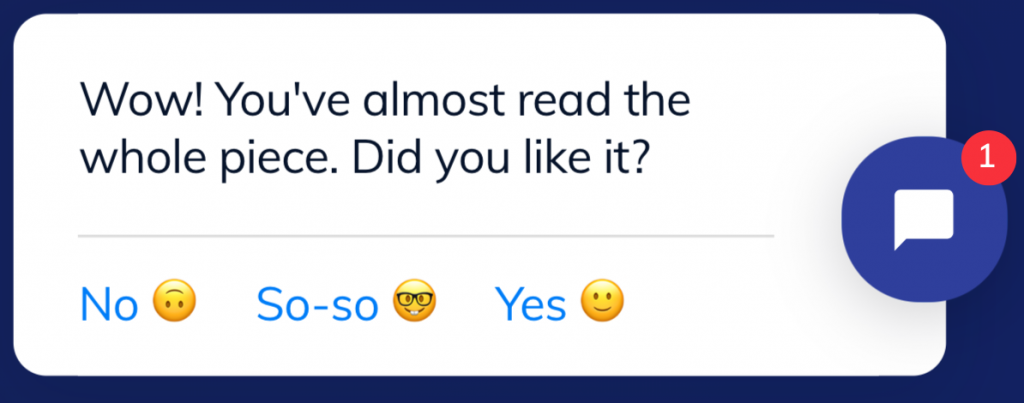
Feedback chatbot. Source: Tidio
All answers are recorded so you can define what blog articles received the best – and the worst – feedback.
Since a chatbot’s text is fully customizable, you can also ask about topics and ideas to write. E.g. “Are you more interested in reading how to do Facebook advertising or email marketing?” A chatbot’s answer buttons will help to record answers quickly plus the process takes a second, which minimizes friction.
Get Topic Ideas with Content Discovery Tools
While surveys and chatbots are collecting feedback, you can turn to content discovery tools. They’re designed to find the most popular content based on your keywords.
For example, with Buzzsumo, you can find articles that were shared the most on social media. Here are the results based on the “web push notifications” inquiry.
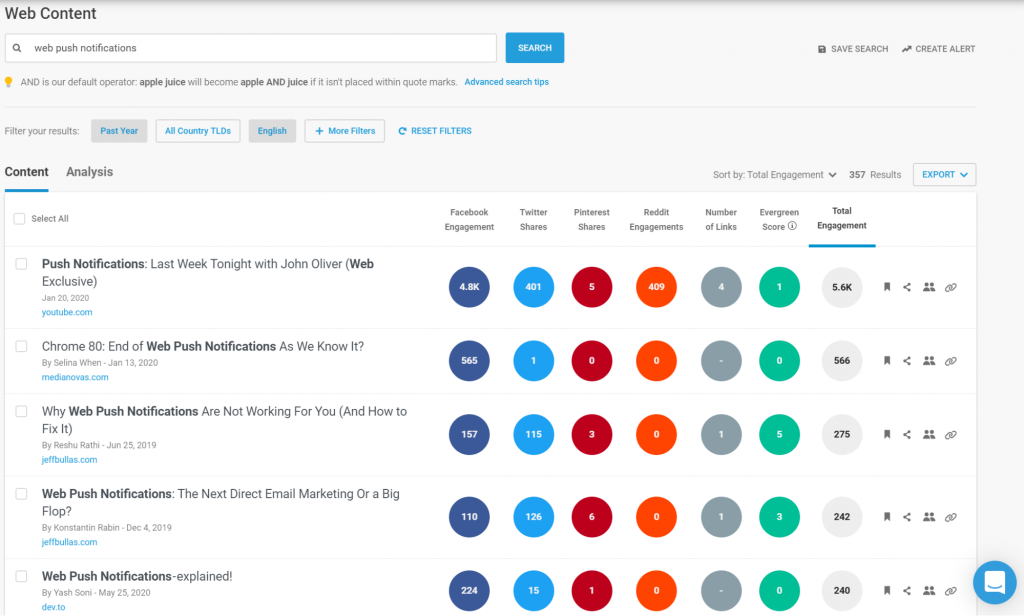
Content discovery tool. Source: Buzzsumo
Popular articles can help to discover more content ideas that give a good chance of increasing visitor engagement.
Ultimately, make a list of content types, ideas and topics as suggested by your readers/content discovery tools/content personas and get to writing.
2. Distribute More Content with Push Notifications
Let’s suppose that your new content strategy is up and running. You’ve got great blog articles published every week and there’s a lot more coming up.
More people need to read them, so it’s time to work on a content distribution plan. It’s a major part of content marketing that can keep people constantly returning to your website.
One powerful way to distribute content to leads is to send out push notifications.
Chances are you’ve seen them many times already, as many businesses rely on them to increase website traffic. You visit a site and see a small pop-up like this, offering to show notifications of fresh content in your browser.
Push notifications can keep leads or customers updated on content that gets published on your website and convince them to go back.
Those who allowed content notifications are more likely to return, so by using update notifications, you’re making it easier for them to do that.
For eCommerce brands, push notifications can do even more. You can send out notifications of product updates, sales, and coupons.
For online shoppers, receiving such notifications would be a familiar way to get useful product-related information.
Since 50 percent of them follow brands on social media to learn about new products and services quickly, they are likely to enjoy getting fast notifications of sales and promotions.
3. Offer Incentives
How to drive traffic to your website fast?
Incentives.
They are a great way to provide a great reason to return. That’s why you need to try offering returning visitors something to increase their interest.
Here’s how you can do it.
E-commerce businesses can give a small discount for the next purchase via a pop-up window, email, live chat, or a chatbot.
For example, here’s how a website live chat gives a discount to encourage buying.
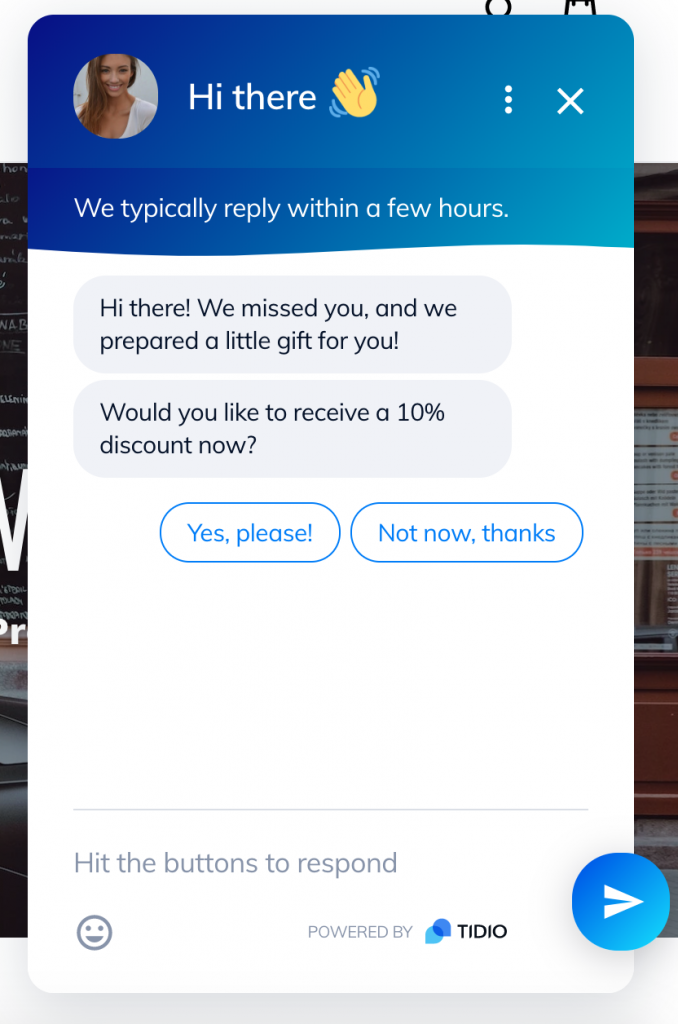
A website live chat widget. Source: Trusy.co
There’s one big advantage of using a live chat or a chatbot for this. It needs the visitor’s email to provide the discount. So you can also build a base of leads’ emails, create a newsletter, and share offers and product updates.
Have an email list already?
Use an email verification tool to ensure that your messages reach real people and share your content or deals regularly to keep them coming back.
Another good idea for B2C businesses is a customer loyalty program. Being a part of this program should be a rewarding experience, so consider using perks like free shipping, surprise gifts, discounts, priority waiting list, and access to premium content.
B2B SaaS businesses can give these information products to increase website traffic:
- extended free trials on your products/services
- access to premium content like industry reports, webinars, and interviews of decision-makers
- early access to new features and beta software versions.
So, using incentives is a good way to get more returning visitors and drive purchases. The incentives themselves will depend on your business, but try different options to see what performs best.
4. Check Your Website’s UX
A lack of a simple-to-use and intuitive UI can also increase the bounce rate.
If the visitor finds it hard to navigate your website, he or she will be more likely to leave and never return.
Although it seems like navigation is something that could be easily fixed with choosing the right website templates or even building a custom website from scratch, the reality is a bit different.
Here’s a simple example.
Website visitors might not know what’s hiding behind common menu sections like “Services,” “Products,” “Resources,” and “Solutions.” “Resources,” for example, could mean a blog, a knowledge base, or a collection of free tools.
However, many companies, especially those working in the B2B industry, still rely on these labels for website navigation. As a result, they’re increasing the space of confusing their visitors with unclear navigation.
This is a major reason why the bounce rate on many websites is high.
If this is a problem that you might be facing, too. So, we need to find out where your returning visitors leave your website. This will show you the pages where the navigation might be unclear and needs testing.
It’s really easy and can be done in the good old Google Analytics. It allows identifying the “drop-off” pages on your website where returning visitors exit it.
Here’s how to find these pages.
Add Returning Visitors segment to the analysis by checking a corresponding section in the segment selection panel.
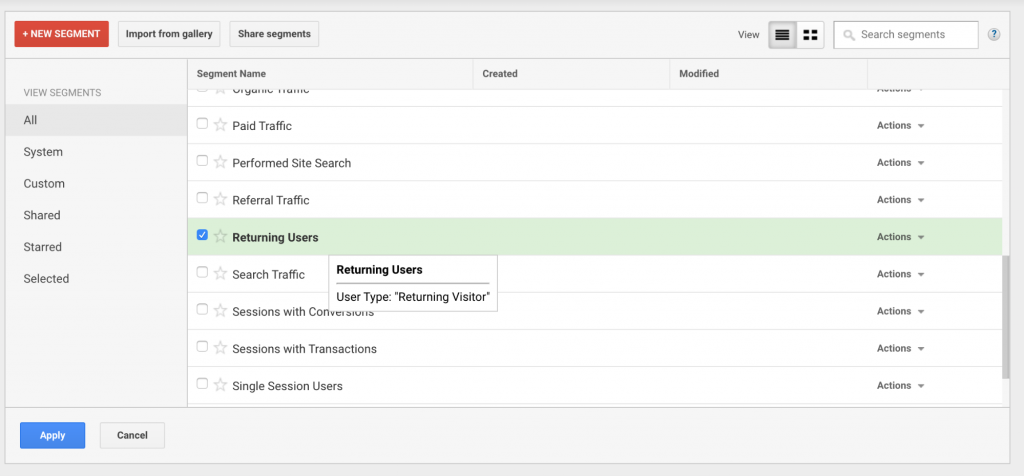
Google Analytics, Author’s Screenshot
Next, go to Behavior > Behavior Flow.
This section shows the most common paths your visitors take to navigate through your website.
Here’s an example of what you might encounter.
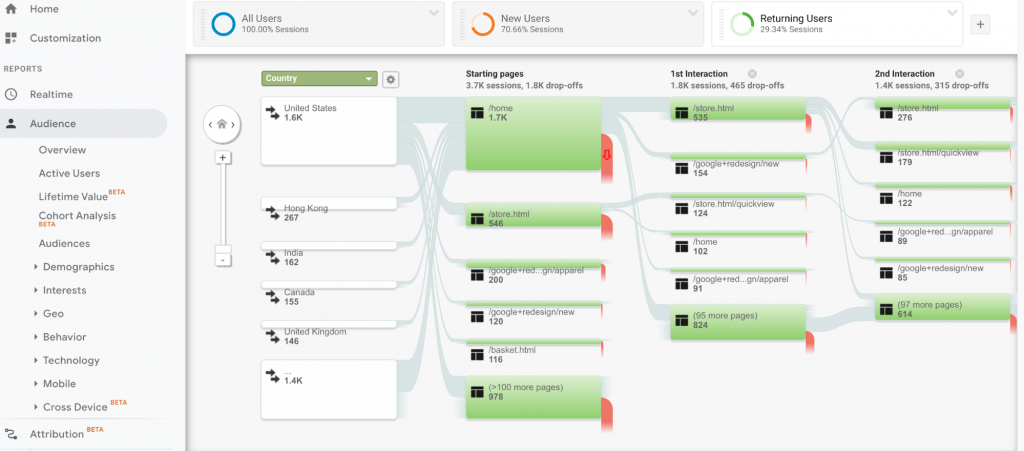
Google Analytics, Author’s Screenshot
The image shows that the visitors begin on the starting page (“/home”). The “/store” section is another major starting point, which suggests that a lot of visitors are looking for products.
By reviewing the number of drop-offs in this section, you can identify pages that cause them. UX issues such as design, navigation, and even loading speed can be the reasons leading to the drop-offs.
Check the usability and performance of the pages with the highest drop-off rate. Also, feel free to change the country of visitors and other options if you need to check the engagement by location.
Pro tip: Behavior Flow isn’t the only tool inside Google Analytics that could help with evaluating page experience.
There are more Google Analytics tools, including In-Page Analytics, to give you more data on bounce rate and in-page click data.
5. Be Active on Social Media
Apart from your website, social media will play an important role in content distribution and driving traffic.
Your potential customers go there to read, watch videos, and get updates from favorite brands, so it’s a perfect place to connect with them.
In addition to that, having a social media presence can also lead to additional revenue channels for your business, especially on networks like YouTube, Instagram, and Tik Tok.
Build a social media community around your brand by consistently sharing content. If you lack the time or expertise for such a project, you can hire a social media virtual assistant and delegate all social media marketing tasks to them.
To maximize the engagement and the chance of driving people to your website consistently:
- Share content your audience loves. Content is the single most important thing that engages social media users, so use the content persona and other research findings you have
- Host contest and giveaways. They are an effective tactic to engage people and build decent followership quickly. This social media contest, for example, generated 14,000+ new followers and 3,900+ trial sign-ups in one go
- Focus on creating visual content. Content like infographics, images, and videos perform better on social media. You can create them for free with visual content creation tools.
- Engage in conversations. Commenting and replying or reacting to comments is a must for keeping people interested and engaged.
Keep in mind that posting times on social media affect engagement with posts.
The best day and time to post for your business could differ, so try starting with these times and adjust according to engagement.
Conclusion
Returning visitors are more likely to engage and convert than new ones.
That’s why getting as many of them as possible should be a major goal for your business, regardless of your industry or niche.
Start by producing quality content and focus on audience engagement with the effective distribution. In the process, measure the effectiveness of your strategy and improve as you go.
What Is WooCommerce Product Slider and Why Your Store Needs It
Why Do Product Images Matter So Much in Online Stores? When someone visits an online store the…
0 Comments9 Minutes
How to Streamline Your Customers’ Shopping Experience?
The goal for any online store is to make shopping as smooth as possible. When visitors move…
0 Comments8 Minutes
Strengthening Brand-Customer Relationships Through Gamified Loyalty Programs
Creating lasting connections with customers has become increasingly vital as the marketplace grows…
0 Comments6 Minutes
How to Use SEO and SEA Together in Search Engine Marketing
In digital marketing, search engine marketing (SEM) plays a critical role in improving online…
0 Comments10 Minutes
Content Marketing Growth Hacks: Real Shortcuts to Drive Traffic
Are you still lagging in content marketing? Sticking to these old strategies seems…
0 Comments10 Minutes
How to Build a Strong Local Following Using Social Media Marketing
In the days of likes, shares, and stories, local businesses have a golden opportunity to create…
0 Comments9 Minutes
Why WooCommerce is the Best Choice for Your Online Store?
WooCommerce stands out as a top option for anyone looking to build an online store. This platform…
0 Comments8 Minutes
How to Use AI-Powered SEO Tools for WordPress eCommerce
SEO is a critical factor in the success of any e-commerce WordPress store. As competition…
0 Comments11 Minutes








